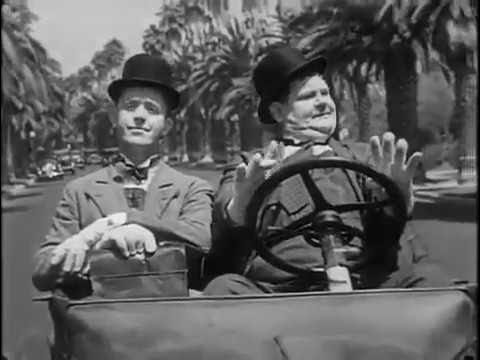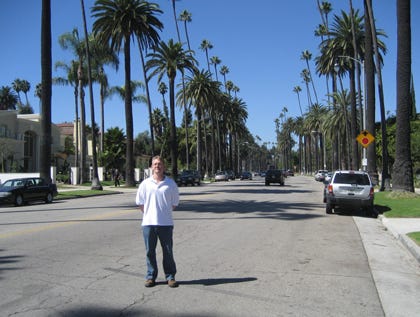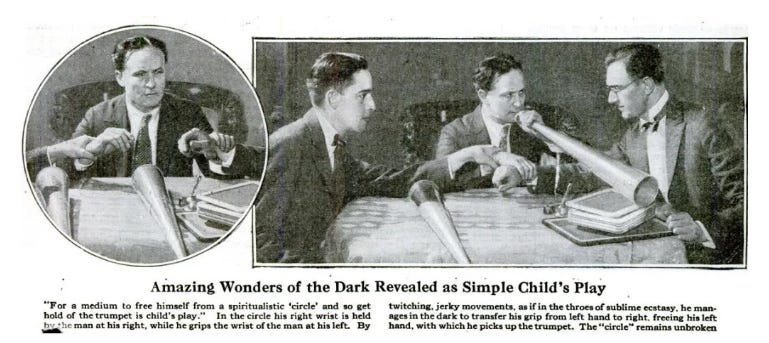Random word: Palm.
A fixture of the L.A. skyline is the stately palm tree. Way back when the city was flexing its sun-kissed muscles and announcing it would become a major metropolis someday—we’re talking 1890s here—and people from the east were flocking here by the trainful, drawn by the promise of warm, golden rays even in winter, and the prospect of plucking fresh oranges right off the trees, it was then that movers and shakers and money makers decided that the hearty palm tree would blanket the city and give it the look of an oasis in the desert, which is how the boosters advertised us in the papers of Boston, New York, and Philadelphia.
Thousands upon thousands of little palm trees were planted. You can see them in the below photo from the 1933 Laurel and Hardy short called “Busy Bodies.” This was filmed on Canon Drive in Beverly Hills:
Here is what Canon Drive looks like today, courtesy of The Terrible Catsafterme blog:
All over the city today, tall and swaying, gazing over the landscape like a giant herd of shaggy giraffes, is the palm tree. It’s the feature I like most about my town.
There is another use of the word palm—palm readers. They were prevalent in early Los Angeles. If you look at newspapers from the early 1900s you’ll find ads for all kinds of spiritual flummery, from swamis to mediums to phrenologists (who claimed you could feel a person’s head and draw conclusions about the subject’s personality and mental capabilities) to palm readers. These con artists raked in the dough, and still do so in various forms today.
Near the Van Nuys courthouse in the Valley (that’s San Fernando Valley to you outsiders), on Van Nuys Boulevard, there is a psychic shop called Soulmates right next to a Bail Bonds office (they should merge and call the business Cellmates).
So a girlfriend can go and try to get bail for her jailed boyfriend, then go next door to find her next boyfriend. This is called convenience shopping.
Mediums were a bustling business in the L.A. of the 1920s. They fooled a lot of grieving widows with messages from dead husbands, using all manner of gimmickry to create the illusion.
This angered the legendary magician Harry Houdini, who made it his mission to expose these fakers. He showed how they made tables move, created ghostly voices, and rang bells with their feet.
Houdini had a famous public tiff with Sir Arthur Conan Doyle, who was an advocate of Spiritism and whom Houdini tagged as one of history’s “greatest dupes.”
Houdini even took his concerns to a congressional hearing in 1926. It did not result in a bill, as the politicians concluded that the First Amendment tacitly affirms the right of a fool and his money to be soon parted.
Houdini told his beloved wife, Bess, that if there was any way to communicate with her from beyond, he’d find it. Bess faithfully attended annual séances until Halloween, 1936, announcing: “Houdini did not come throughI do not believe that Houdini can come back to me, or to anyone.”
That hasn’t stopped many other attempts by spirit fans and fakers, who are still around to take your money.
America has always been free soil for the seeds of fraud. Back in the Civil War days, when photography was just catching on, a guy named William Mumler figured out how to do a double exposure, which meant he could shoot a subject and then later put an image of another person in the photo, with a ghostly transparency.
Since spiritualism was on the rise, and there was an abundance of parents who’d lost sons in the war, Mumler did a brisk business in photos of the grieving mom or dad, with the son looking at them in the background. He reportedly stole pictures of the dead from the homes and then found a model who resembled the departed.
He even did a shoot with Mary Todd Lincoln that had Abe behind her with his loving hands on her shoulders!
Eventually Mumler was put on trial for fraud. One of the witnesses against him was none other than another famous fraudster, P. T. Barnum. Barnum introduced into evidence a photo of himself with Honest Abe behind him, taken by a photographer named Abraham Bogardus.
Amazingly, Mumler was acquitted, as the prosecution could not prove Mumler had actually fabricated the pics.
And in true American fashion, the publicity from the trial boosted Mumler’s profile and practice. He continued to make moolah from mourners.
Today, scammers continue to expand the boundaries of fraud. They’re now able to use AI to create phone messages that sound like a real person and not that obvious computer voice that warned you the IRS is about to seize your first-born child.
Stay vigilant, friends. Mistrust and verify!
Quote of the Week: “Every crowd has a silver lining.” – P. T. Barnum











It's funny how the big fraud mentioned by Sherry suddenly disappeared, virtually overnight!
I wrote about a big fraud going on before our eyes but erased it because you probably don't want political stuff on your site. 🫤